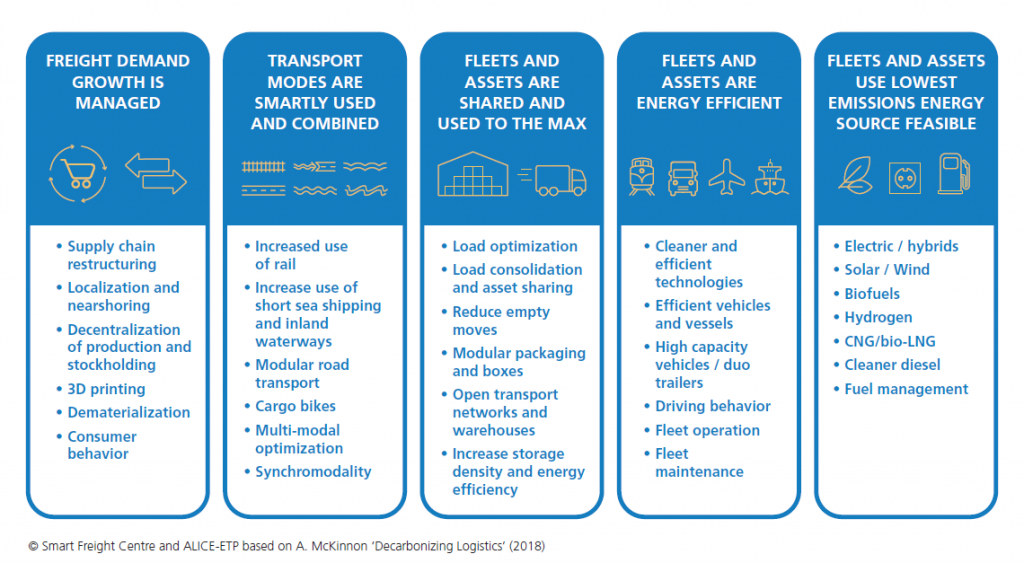Transport as a sector is considered a growing contributor to global climate change. According to the International Transport Forum (ITF), freight transport accounts for about 39% of transport CO2 emissions and around 8% of CO2 emissions worldwide. It’s also a major contributor to air pollution. Road constitutes 62% of emissions, while sea contributes 27%, air 6%, rail 3% and inland waterways 2% (European Commission, 2018).
As it stands, the total emissions from freight need to be almost fully decarbonised by 2050 compared to the 2015 levels if we are to meet the climate ambitions set out in the Paris Agreement, which came into force in 2016. However, the real challenge facing us is that global transport demand is estimated to triple by 2050, which would mean doubling carbon emissions under a business as usual scenario.
In response to the Paris Agreement, more and more governments, associations and businesses are setting bold climate targets. The ambition is for Europe to be the first climate-neutral continent in the world by 2050. This will be achieved with a two-step approach, designed to reduce CO2 emissions by 50%, if not 55%, by no later than 2030.
In such a context, the Alliance for Logistic Innovation and Collaboration in Europe (ALICE), in which Algeciras Port Authority is recent a member, is aware of the huge challenges and deep transformation required of freight transport and logistics if we are to meet climate goals and maintain our standard of living. That is why ALICE developed a roadmap entitled «Towards Zero Emissions Logistics 2050» to set the challenge and direction clearly.
This roadmap, which is a first step towards such an intelligent freight management provides a framework for a decarbonization consisting of five solution areas, four stakeholder groups (companies, governments, R&D and civil society) and three transition management measures where stakeholders need to collaborate over time.

With regards to the specific solutions the top ranked ones are in order of potential (impact and feasibility) the following ones:
- Renewable energy in combination with electrification, hybrids and hydrogen (High reduction impact at short term today-2022 and medium term 2023-2030).
- Multimodal optimization (High reduction impact at medium term 2023-2030).
- Load consolidation and optimization (Medium reduction impact at medium term 2023-2030).
- Use of efficient vehicles, vessels and fleets (Medium reduction impact short term up to 2022).
- Synchromodality and flows synchronization (High reduction impact at medium term 2023-2030).
- Improve fleet operation (Short reduction impact short term up to 2022).
- Supply chain restructuring (High reduction impact at medium term 2023-2030).
- Consumer behavior (High reduction impact at medium term 2023-2030).
There is also a link with the Physical Internet that combines many of these solutions. It is expected that the increase in efficiency and productivity of freight transport and logistics will bring the savings and value needed to enable companies to pay for the required asset transition (i.e. towards the greening of all transport assets).
The Physical Internet as a solution for a more efficient logistics system
Going into further detail, Physical Internet is pursuing an open global logistic system founded on physical, digital, and operational interconnectivity, through encapsulation, interfaces and protocols design, aiming to move, store, realize, supply and use physical objects throughout the world in a manner that is economically, environmentally and socially efficient and sustainable. The goal is clear: Achieve that future supply networks will operate under a synchro modular transport system, in which shipments are to a large extent automatically routed from source to destination through a network of hubs and spokes in an optimal way.
To get to the next levels, shippers (manufacturers, retailers), carriers and other providers of logistics services should take the broader sustainability goals into the economic equation. This requires ways to base decision making in the system on financial and market criteria but also on safety, security and environmental/ecological aspects. Transnational governance and regulation are needed to achieve such a cultural shift, and to encourage collaboration, coordination and horizontal partnerships.
Thus, a major challenge is to design a multifaceted decision support system for the physical internet, with partly automated execution via intelligent agents. Radical new business models based on openness and sharing resources are required, as opposed to the current local ownership and control of resources.
Therefore, the adoption of a Physical Internet will require radical changes with respect to the roles and responsibilities of many stakeholders. Achieving such a combination of physical and electronic infrastructure is just one step, stimulating shippers and logistics operators to connect to it, is an even bigger challenge.
Photo by Chris Pagan on Unsplash and text partially extract from ALICE.




Deja una respuesta